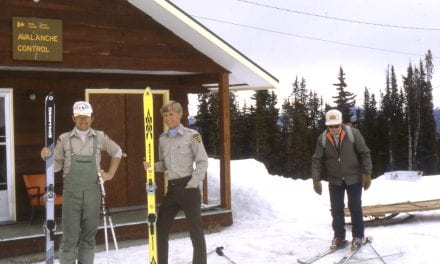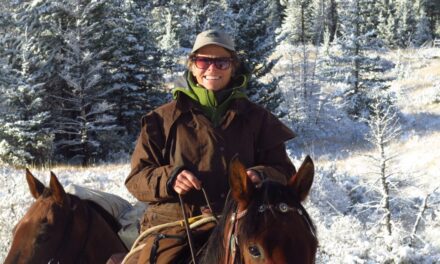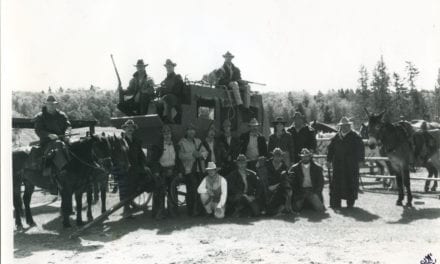(15:43) Sharon – Then when we came to Jasper we were supposed to be anyways, responsible parents! Thank god children are little for so long! In Jasper.
(16:03) Gord – And we were still assigned to the backcountry districts at that time, the Rocky River.
(16:11) Sharon – Well, I lived in Beaver cabin which is off the Maligne Lake road after I had her, before that we were in the Rocky River. Gord was still in the Rocky River, but I stayed at the cabin that winter with Travis and Rundi which was like a backcountry cabin, but it was accessible most of the time, not all of the time…
(16:34) Gord – If you had a big storm come along you lost your access. It was right at the upper end of Medicine Lake…
(16:42) Sharon – Mac Elder and Cathy lived at Maligne Lake. So they were further and then we were the next ones. They were a good resource too when you were gone.
(16:57) Gord – When we were up in the district coming out Mac would go over to the place and light the fire and get it all warmed up for us. He would come up to meet us at Summit Lake sometimes. He was good. He was our manager and he was good to us.
“A lot of people I spoke to have said what a good manager Mac was and have talked about that sense of family within the service.”
(17:25) Sharon – Yeah we sure felt it, because we were young. We weren’t young, young. but we were young compared to the people we came to. They were all seasoned it seemed.
“In Banff that was the time of centralization?”
(17:37) Gord – Well, the Jasper warden service, it was the same as Banff. The Jasper wardens, a lot of them were ex-outfitters, guide type guys and they all had a wealth of practical experience. We were the first wave of the so called “educated ones” you know. They had hired Jay (Morton) and Ted Anderson in Banff, to my knowledge they were the first university grads hired into the warden service in Canada, prior to the technical grads. But then they decided to go into hiring people with education that is where the transition happened in the early 1970s. Yeah, in Banff they were decommissioning (the backcountry districts), Healy Creek was shut down. Minnewanka was shut down shortly after Andy left. I think it was about two or three years later, it was in the 1970s sometime.
(18:39) Sharon – That is why we loved so much going to Jasper. We were able to be a backcountry family. They sort of semi did it after us. We were one of the last, but there was still (some families in the backcountry). Like Terry and Ursula (Winkler) worked in the Brazeau district in the summer in the early 1990s and they had their son Peter with them who was a preschooler at the time. Barb and Bob Barker were travelling at the same time as we were in the backcountry and they lived at Snaring and we lived at Beaver and then we lived at Athabasca Falls. We still had that opportunity.
“How long were you a backcountry family?”
(19:17) Gord – Jasper was a much slower transition. I think it was partly because of the way the districts were situated and where they needed people to be sort of thing. We weren’t there all that long. We went in 1971, and I spent two seasons in the backcountry, but again it was a transitioning period there. During the winter of 1971/72, Mac Elder moved to town and then transferred out of the park to a chief warden position in Pacific Rim. Ray and Kay Frey moved to Maligne for the summer of 1972. When Mac moved to town, Max Winkler assumed supervision of the Maligne and Rocky River districts…It was just the way things were, so I didn’t work in the district fulltime…
(20:05) Sharon – But we still lived there.
(20:06) Gord – Yeah, we still lived at Beaver that winter of 1971/1972. I traveled the district, but not fulltime. I came into town to work a little bit. Also there was some training going on at the time. I was actually over at a deep powder school in Glacier in January of that year. I guess it was January of 1972. A humongous storm hit the whole country here and at Glacier – there was eight feet of snow in five days! We got snowbound there, we couldn’t ski. And Sharon was at Beaver cabin with Travis and how many months pregnant? It snowed about two or three feet here in Jasper, so somebody had to come and rescue her with a 4×4 truck. Thanks to Bev Hunter, our secretary, she said “You better get your butt up there and get Sharon out of there!” Anyways that was quite an experience for us, that big storm.
(21:24) Sharon – Actually bringing Rundi home was quite a challenge too, back to the cabin because there was flooding all over the place so we ended up spending quite a bit of time in town at Bev’s house actually.
(21:39) Gord – First of all the slides came down Medicine Slabs and the road was plugged. I mean the Parkway was plugged for a month or more, so they worked on that until that was clear and then they went and did the side roads. Finally they got around to Medicine Lake about April. In April/May they were still working on cleaning that up with all the timber that came down and because of all the snow when things started melting the lake was just (overflowing)….It was all a result of that one big storm, plus the follow up storms after that.
(22:17) Sharon – That was the other reason why he said he didn’t spend a lot of time in the backcountry that winter because he was cleaning highways and working with stuff like that.
“So in 1972 then did you move into town?”
(22:31) Gord – Yep, we were in town for two years. We moved to Athabasca Falls in the summer of 1974, it was about a year and a half (in town)…The year and a half at that point was the last time that we lived in town ever. We were always outside of town (after that).
(22:57) Sharon – We lived in Athabasca Falls for six years.
(23:02) Gord – Then we were at Sixth Bridge for 18 years. It was where the warden office was.
(23:11) Sharon – The old warden office.
(23:13) Gord – That was where the warden office and fish hatchery were situated. The fish hatchery operated until a virus necessitated closure. At that time the warden service was in dire need of more space. Our chief, Don Dumpleton was given approval to develop the old hatchery as warden headquarters.
(23:15) Sharon – At one time it was the fish hatchery, the house was for the head of the fish hatchery. The superintendent of the fish hatchery had that house. Then they shut the fish hatchery down and it became the warden office.
(23:34) Gord – In about the mid 1970s, 1974/75 somewhere in there.
(23:37) Sharon – There was one family living there ahead of us right?
(23:41) Gord – Duane Martin lived there for a number of years with his wife and son. We moved in after they moved out of the hatchery house.
(24:02) Sharon – We followed the Haney’s to the Rocky River and then we followed them to Athabasca Falls…We were the second or third family to move into Sixth Bridge.
(24:25) Gord – We were there for the duration because then things kind of tightened up.
(24:27) Sharon – They changed the office.
“What were some of your different assignments?”
(24:30) Gord – Again they changed the organization around so that people didn’t move around as often. We certainly didn’t. We were there for 18 years, but I had several different assignments while we lived there. I didn’t work in the same function. In 1980, I was working with Haney actually in the resource management section. I was the liaison with the CN (Canadian National Railway) double tracking for four years, 1980 to 1984.
(25:08) Sharon – Was that before the bear study?
(25:09) Gord – That was after the bear study, we were still at Athabasca Falls when I worked on a grizzly study.
(25:15) Sharon – You didn’t tell her that.
(25:16) Gord – Oh, I didn’t tell you that?
(25:17) Sharon – Because that was one of the highlights of your career.
(25:19) Gord – Yeah, that certainly was.
(25:24) Sharon – So after the backcountry…
(25:28) Gord – After the backcountry when we went to Athabasca Falls, we worked as a district warden there under Toni Klettl and then they didn’t move us, but we went to work under (Bob) Haney actually…How that happened I can’t remember…Anyway I ended up working for Haney in resource management and we were still living at Athabasca Falls. This grizzly study started in 1975. It was done pretty much the same time as the one going in Banff…in the 1970s.
(26:07) Sharon – And it was with…
(26:10) Gord – Billy Vroom and Steve Herrero did the Banff study basically. Billy was the warden assigned to it. Up here it was Norm Woody…He was working with the CWS, the Canadian Wildlife Service, but his health failed on him after a couple of years. They pulled him off the field work and shipped me out. I spent two summers chasing bears around the park, which is pretty hard to take! That study ended because the funding was withdrawn. The study ended in 1978.

Gord Anderson working on the grizzly study at Cairn Pass – 1977
“Where was the burn?”
(26:56) Gord – Then I guess I was working in fire management for a couple of years with Bob Haney. I was prior to and after that too (working in fire management). In 1975 actually I was part of the first prescribed burn in national parks…We had the Canadian Forestry Service involved, an expert from the States, George Fahnestock, and Bob was the supervising warden. Actually that was when we had some really good knowledge in the Canadian Forestry Service…there was some real world renowned fire experts working for these guys in Edmonton…we lost all those resources eventually when they brought in all our own scientists so to speak. Yeah, it was in Jasper. It was a pretty conservative burn, but it was a start. We did it out on the Henry House grasslands, north of Jasper along Highway 16.. Then that whole program lay dormant for several years. I wasn’t involved anymore, by the time they got going again.
(28:20) Gord – In 1980, the railroad job came up and I was involved with four years of liaison there. That was quite interesting too, working with contractors and CN authorities and so on. Bob was still involved and then Duane was part of that, Duane Martin. Bob and Duane swapped function responsibilities, law enforcement/resource conservation.
“Did you enjoy that?”
(28:52) Gord – After that I guess I went into the enforcement shop after that, 1985 or so, somewhere in there. From approximately 1985 to 1990 I worked in the enforcement section. I was the court liaison warden there. I organized all the files and did the “court thing” which entailed attending the weekly provincial court sessions and presenting the warden files. It was interesting. Law enforcement wasn’t my forte, but it was quite interesting.
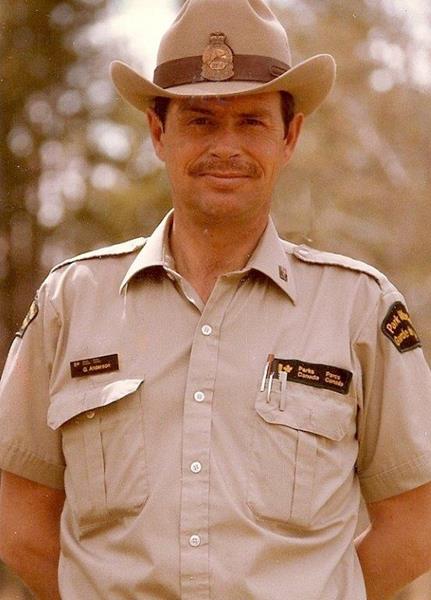
Gord Anderson Jasper park warden – 1985
(29:32) Sharon – He is a good organizer.
(29:34) Gord – I think we progressed quite nicely during that time because we became much more professional in how we presented our files and so on. But by 1990 I had had enough. Rundi graduated from high school and I got a job in the backcountry again. I was the backcountry coordinator. That went for four years I guess, until about 1994. Then after that it was just sort of a potpourri of jobs, but still in the operations section (formerly law enforcement) until retirement in 1998. But we made as many backcountry trips as we could swing! In the summer I was involved in horse related work whenever I could manipulate my manager to allow me to get off the “highway!” My last paid trip was with our son Travis. It was a great way to end it…

Gord at Miette Lakes – 1990
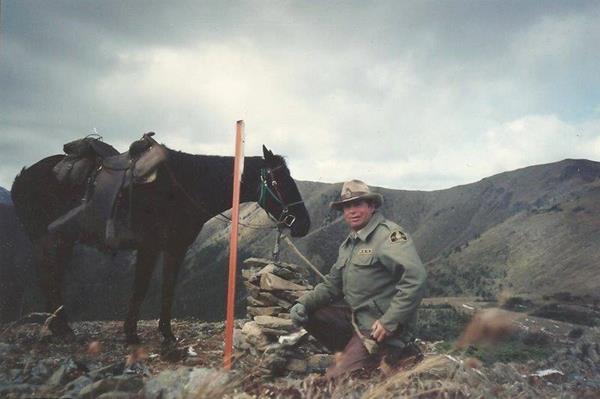
Gord on Moosehorn boundary patrol – 1990
“What was it about the warden service that was important to you? Was the adventure, the idea of protecting things?”
(30:58) Gord – Well, I wasn’t really an adrenaline junkie. I didn’t say much about wildlife, but I really enjoyed that and I had a lot of exposure to bear problems and I found that interesting. We had the elk transplants, anything to do with wildlife I was quite interested in.
(Gord later added, “The majority of my wildlife management adventures occurred through the 1970s and into the early 1980s. About then guys found themselves creating their little empires, which I should say wasn’t entirely planned on. It just happened with the move to become more professional at what we did.”) The backcountry too was pretty much the highlights of my career, the wildlife and backcountry mostly, and I enjoyed the horse work.

Gord Anderson at Dolly Lake – 1994
(31:36) Sharon – You enjoyed mentoring too, you enjoyed teaching.
“It sounds like a fascinating career.”)
(31:38) Gord – Oh yeah, I worked with the young people. The last four years or so I did a lot of that with new people coming on. I would take them one-on-one sort of thing. It was good yeah, I enjoyed it!
(31:57) Gord – There were just periods of time…I think when I did come around to retirement time they were starting to do this phasing out thing. We could see it coming…It isn’t a big surprise where we are at now, but it is pretty disappointing.
“It was an amazing life that you offered your children.”
(32:17) Sharon – Really to be honest when we got married we kind of looked at what kind of lifestyle we wanted as a married couple and as a family. We made a conscious decision. We talked about going north and earning money and becoming farmers. We thought we had to have lots of money to become farmers! There’s that little joke, win a lottery and farm until you spend all your money. We thought of that and then we looked at the warden service, Gord was quite interested in it. We knew the writing was on the wall that he would have to go back to school if he was going to become a warden. So that is where we made the decision…We liked adventure and definitely did not want to live in town, so what was going to supply us with the lifestyle and also the family? We both (come from large families), Gord is the youngest of ten. So family was really important to us and for us to have a family what would we be offering our children? What type of life? Yeah, I really feel blessed that we were able to raise our children in that environment. (I look at both of them now and we are so proud of them. The way they are is because of the life that we were able to provide and the community, the community of wardens. You know I still see the kids getting support from our friends that are far away, like the Stendie’s and Bob Barker. I can remember when Rundi got her job as a warden, Bob came and he gave her this warden hat. It was from Norm Young from Waskesui who he inherited it from. It was like a boating hat. He gave it to Rundi because she was out on the water (at Pacific Rim National Park). Also they all think of our kids as their family and we watched Honya and Cheryl grow and Larissa now (Al Stendie’s daughter). She still sends us the odd email from Norway and she has come to visit us. I really feel blessed that we had the warden service as our family. You know I think that there is a little bit of that still. I think that was one of the things that was hard for Rundi to leave because they had what they called the Powwow Girls and those are the Pacific Rim women. They still are all very, very tight. So she acquired that feeling as a young woman of having that as her resource also.
